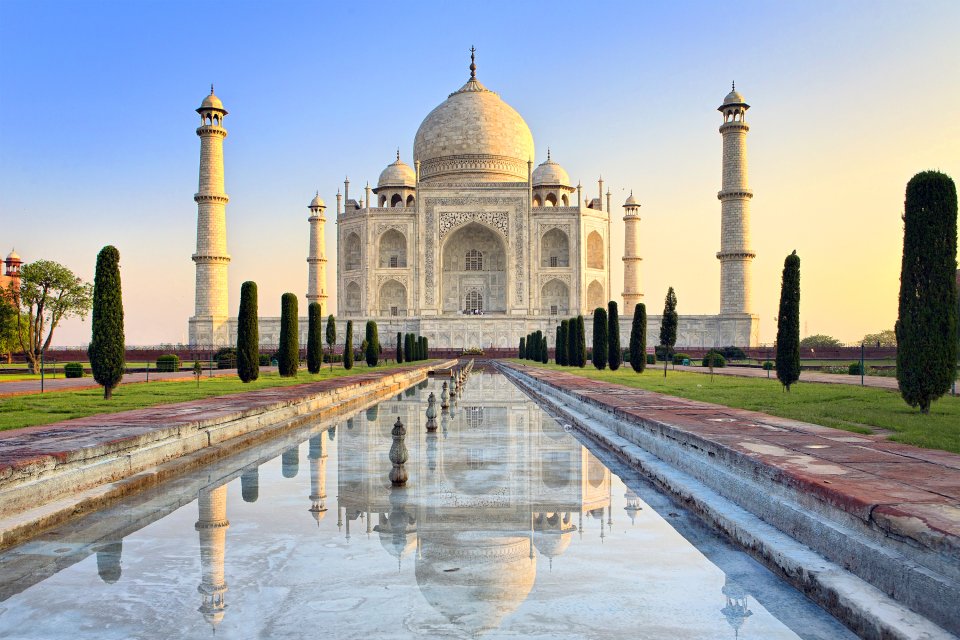Il Taj Mahal è un mausoleo che si trova nella cittadina indiana di Agra, nell’India settentrionale. Fu fatto costruire sotto richiesta dell’imperatore Mughal Shah Jahan in onore della sua terza moglie, nota come Mumtaz Mahal.
Nel 1631, la donna morì dopo aver dato alla luce il loro quattordicesimo figlio.
Sei mesi dopo la sua morte, l’imperatore fece portare il suo corpo ad Agra dove venne adagiato in una cripta vicino a dove sarebbe stata costruita la tomba definitiva.
Doveva essere il più grande mausoleo mai costruito per una donna. La costruzione iniziò intorno al 1632, si contano più di 20.000 lavoratori provenienti dall’Europa, dall’India, dalla Persia e dall’Impero Ottomano, e oltre 1.000 elefanti. Venne costruito in marmo bianco intersecato con pietre semi-preziose, tra cui cristalli, lapislazzuli, turchese e ametista, che formano disegni intricati in una tecnica chiamata pietra dura.
La cupola centrale raggiunge i 73 metri, è circondata da quattro cupole più piccole e quattro torri sottili si trovano agli angoli. I versetti del Corano sono scritti sugli ingressi ad arco del mausoleo. All’interno, una camera di marmo ottagonale ospitava la falsa tomba di Mumtaz Mahal, mentre il vero sarcofago con i suoi resti giaceva a livello del giardino. Secondo la leggenda l’imperatore intendeva costruire un secondo mausoleo sul fiume Yamuna, dove dovevano essere sepolte le sue spoglie, a cui doveva collegarsi con un ponte. Shah Jahan visse gli ultimi anni della sua vita agli arresti domiciliari in un Forte Rosso, venne sepolto vicino alla moglie. Il Taj Mahal oggi è uno dei monumenti più visitati e significativi del mondo. L’elevato numero di turisti e il grande inquinamento presenti, sottopongono il mausoleo ad un inesorabile declino. Infatti, inizialmente fu vietata la costruzione di fabbriche e industrie entro un raggio di 50 km. Nel 1998 la Corte suprema indiana ha stilato delle norme anti-inquinamento per proteggere la struttura. Il Taj Mahal è stato dichiarato Patrimonio dell’Umanità nel 1987.
Di Elena Perpenti
Traduzione di Elena Perpenti
The Taj Mahal is a mausoleum located in the Indian town of Agra in northern India. It was built at the request of Mughal Emperor Shah Jahan in honor of his third wife, known as Mumtaz Mahal. In 1631, she died after giving birth to their fourteenth child. Six months after his death, the emperor had his body taken to Agra, where it was temporarily placed in a crypt near where the final tomb would be built. It was supposed to be the largest mausoleum ever built for a woman.
Construction began around 1632 and there were more than 20,000 workers from Europe, India, Persia and the Ottoman Empire, and over 1,000 elephants. It was built in white marble intersected with semi-precious stones, including crystals, lapis lazuli, turquoise and amethyst, which form intricate designs in a technique called hard stone. The central dome reaches 73 meters, is surrounded by four smaller domes and four thin towers are located at the corners. The verses of the Qur’an are written on the arched entrances of the mausoleum. Inside, an octagonal marble chamber housed the false tomb of Mumtaz Mahal, while the real sarcophagus with its remains lay at garden level.
According to legend, the emperor intended to build a second mausoleum on the Yamuna River, where his remains were to be buried, which was to be connected with a bridge. Shah Jahan lived the last years of his life under house arrest in a Red Fort and was buried near his wife.
The Taj Mahal is today one of the most visited and significant monuments in the world. The high number of tourists and the great pollution present, subject the mausoleum to an inexorable decline. In fact, the construction of factories and industries within a radius of 50 km was initially banned. In 1998, the Indian Supreme Court drew up anti-pollution regulations to protect the structure. The Taj Mahal was declared a World Heritage Site in 1987.
